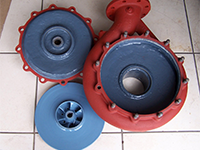Use Of Ceramic Coatings for Metal Parts

There are a huge variety of ceramic coatings that can be directly used to metal elements in order to improve their practical properties. Most ceramic coatings are electrically nonconductive (making them excellent insulators), have a considerably advanced stage of abrasion resistance than many metals, and are able of preserving their reliability under sternly higher temperatures, every so often up to 4,500 degrees Fahrenheit.
Before going to apply a coating, it is vital to make sure compatibility between the ceramic material and the metal surface. Greatly of this compatibility relies on thermal expansion properties, as having extending rates that vary too significantly can cause a coating to break when it is being chilled after application. Additionally, a diffusion layer usually produces on the metal surface, and this can guide to a coating that is too flexible or delicate for the design specifications. Complementary thermal properties will assist to put off heat checking and get better resistance to wear and crack.
Ceramic Coating Processes
When applying a ceramic coating to any object is multi-stage procedure. The introductory stages of cleaning, abrading, and undercoating (or priming) wholly control the success of the plan. The definite coating efficiency depends mainly on the mechanical, chemical, and physical bonds that resolve the coating devotion and definitive power of the ceramic layer. Apart from chemical vapor deposition, the most widespread ceramic coating processes include:
Plasma Spraying:-
In plasma spraying, ceramic powder is flowing through an ionized gas at exceedingly high temperatures, at times close to 30,000 degrees (F). The under pressure gas speeds dissolved ceramic elements toward the substrate where they connection onto its surface. The consequence is a strongly-adhering and high-density coating, but the procedure can be extremely costly.
Detonation Gun:-
The detonation gun method is most efficient for specific ceramic materials, like a tungsten carbide, that are essential for generating extremely thick coatings on a metal surface. It brings a detonation of oxygen and acetylene gas at approximately 6,000 degrees (F), melting the ceramic and firing it at high speed toward the target substrate.
Oxygen Acetylene Powder:-
This process includes heating ceramic powder under a 5000 degree (F) flame, and making use of compressed gas to spray the coating onto the substrate. It brings absorbent coating layers with moderately low sticking to strength.
Oxygen Acetylene Rod:-
In this process, a compound ceramic rod is flowing under an oxyacetylene torch burning at 500 degrees (F). Pressurized gas is then utilized to spray soften ceramic material on top of a surface, forming a coating with a high level of consistent connection.
Moreover to these benchmark processing processes, constant research in ceramic coating technology has unveiled the most advanced techniques that may have a great influence on future ceramics work. For example, a process for coating metalworking dies with intractable materials, like molybdenum and tungsten, employs a plasma spray gun and low-shearing compaction to pull off a highly efficient and wear-resistant coating.









